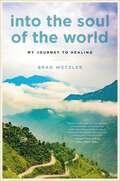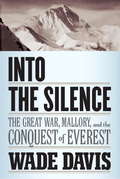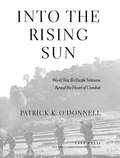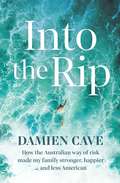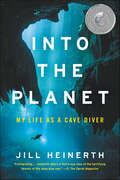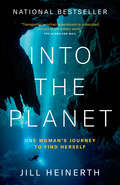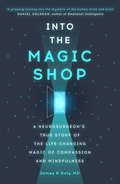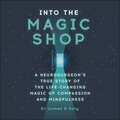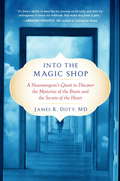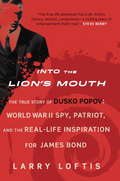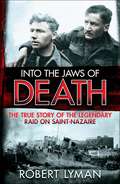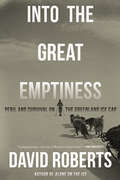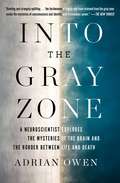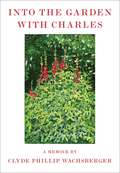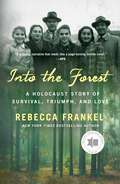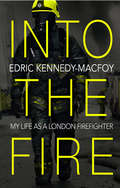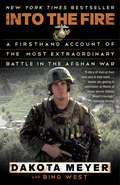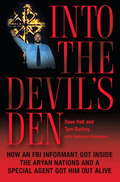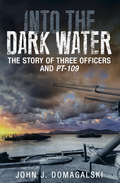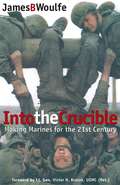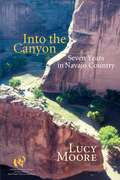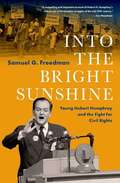- Table View
- List View
Into the Soul of the World: My Journey to Healing
by Brad WetzlerThis powerful memoir shares an adventure journalist&’s story of a decade-long, round-the-world quest to overcome his drug addiction and to understand and heal from past traumas. Suffering from PTSD and severe depression from past trauma, battling an addiction to overprescribed psychiatric medication, and at the rock bottom of his career, journalist Brad Wetzler had nowhere to go. So he set out on a journey to wander and hopefully find himself—and the world—again. Into the Soul of the World is Wetzler&’s thrilling, impactful, and heartrending memoir of healing—physically, emotionally, and spiritually. An adventure journalist at heart, Wetzler mixes travelogue with empowering insights about his inner journey to better care for his own mental health. Journey with him as he travels across Israel and the West Bank, before moving on to India, a candle-lit cave on a mountaintop in the Himalayan foothills, and a life-changing encounter with a 100-year-old yogi. Wetzler's writing is full of the poignant, amusing, and occasionally heart‑breaking situations that unfold when we finally decide to confront depression (or any mental health struggle) and declare ourselves ready to heal: How do we heal our past and thrive again? What does it mean to live a good life? How can we transform our suffering and serve others? His answer: live to tell the story and find the humility and courage to be the best human you can be.
Into the Silence: The Great War, Mallory and the Conquest of Everest
by Wade DavisOn June 6, 1924, two men set out from a camp perched at 23,000 feet on an ice ledge just below the lip of Mount Everest's North Col. George Mallory, thirty-seven, was Britain's finest climber. Sandy Irvine was a young Oxford scholar of twenty-two with little previous mountaineering experience. Neither of them returned. In this magisterial work of history and adventure, based on more than a decade of prodigious research in British, Canadian, and European archives, and months in the field in Nepal and Tibet, Wade Davis vividly re-creates British climbers' epic attempts to scale Mount Everest in the early 1920s. With new access to letters and diaries, Davis recounts the heroic efforts of George Mallory and his fellow climbers to conquer the mountain in the face of treacherous terrain and furious weather. Into the Silence sets their remarkable achievements in sweeping historical context: Davis shows how the exploration originated in nineteenth-century imperial ambitions, and he takes us far beyond the Himalayas to the trenches of World War I, where Mallory and his generation found themselves and their world utterly shattered. In the wake of the war that destroyed all notions of honor and decency, the Everest expeditions, led by these scions of Britain's elite, emerged as a symbol of national redemption and hope. Beautifully written and rich with detail, Into the Silence is a classic account of exploration and endurance, and a timeless portrait of an extraordinary generation of adventurers, soldiers, and mountaineers the likes of which we will never see again.From the Hardcover edition.
Into the Rising Sun: In Their Own Words, World War II's Pacific Veteran
by Patrick K. O'Donnell"Iwo Jima was a massacre. I never expected anything like that. People were dying left and right...No names should have been used on the flag raisings because we didn't get up there by ourselves. It was the collective actions of a lot of people and there were a lot of Raiders and paratroopers up there with us." -- Charles Lindberg, Flag RaiserPatrick O'Donnell has made a career of uncovering the hidden history of World War II by tracking down and interviewing its most elite troops: the Rangers, Airborne, Marines, and First Special Service Force, forerunners to America's Special Forces. These men saw the worst of the war's action, and most of them have been reluctant to talk about it. With O'Donnell's respectful coaxing, however, they first began telling their stories through www.thedropzone.org, his award-winning Web site. In 2001, veterans of the European Theater told their stories in O'Donnell's first book, Beyond Valor. Now, in Into the Rising Sun, O'Donnell presents scores of veterans' personal accounts, based on over a thousand interviews spanning the past ten years, to tell the story of the brutal Pacific war."They were making a lot of noise, talking, yelling to one another, and I heard someone getting beat up on the left. I can still hear the screams. He was begging for mercy. They [the Japanese] were berating him. Later on I found that it was one of my friends, Ken Ritter." -- Robert Youngdeer, GuadalcanalThese veterans were often the first in and the last out of every conflict, from Guadalcanal and Burma to the Philippines and the black sands of Iwo Jima. They faced a cruel enemy willing to try anything, including kamikaze flights and human-guided torpedoes. As O'Donnell explains in the Introduction, most of the men in this book were at first reticent to talk. Over the course of the war, they had spearheaded D-Day-sized beach assaults, encountered cannibalism, suffered friendly-fire incidents, and endured torture as pris-oners of war. Heroes among heroes, they include many recipients of the Navy Cross, the Distinguished Service Cross, the Silver Star, and other medals of battlefield valor, but none bragged about it. As one soldier put it, "When somebody gets decorated, it's because a lot of other men died." By at last telling their stories, these men present an unvarnished look at the war on the ground, a final gift from aging warriors who have already given so much. Only with these accounts can the true horror of the war in the Pacific be fully known. O'Donnell has carefully verified each account by comparing it with official records and interviews, and he intersperses each story with brief commentary. Together with detailed maps of each battle, the veterans' stories in Into the Rising Sun offer nothing less than a complete picture of the war in the Pacific, a ground-level view of some of history's most brutal combat.
Into the Rip: How the Australian Way of Risk Made My Family Stronger, Happier ... and Less American
by Damien CaveWhen Damien Cave brought his young family to Sydney to set up the New York Times&’ Australian Bureau, they encountered the local pursuits of Nippers and surfing – and a completely different approach to risk that changed the way they lived their lives. Damien Cave has always been fascinated by risk. Having covered the war in Iraq and moved to Mexico City with two babies in nappies, he and his wife Diana thought they understood something about the subject. But when they arrived in Sydney so that Cave could establish The New York Times&’s Australia Bureau, life near the ocean confronted them with new ideas and questions, at odds with their American mindset that risk was a matter of individual choices. Surf-lifesaving and Nippers showed that perhaps it could be managed together, by communities. And instead of being either eliminated or romanticised, it might instead be respected and even embraced. And so Cave set out to understand how our current attitude to risk developed – and why it&’s not necessarily good for us.Into the Rip is partly the story of this New York family learning to live better by living with the sea and it is partly the story of how humans manage the idea of risk. Interviewing experts and everyday heroes, Cave asks critical questions like: Is safety overrated? Why do we miscalculate risk so often and how can we improve? Is it selfish to take risks or can more exposure make for stronger families, citizens and nations? And how do we factor in legitimate fears and major disasters like Cave has covered in his time here: the Black Summer fires; the Christchurch massacre; and, of course, Covid? The result is Grit meets Phosphorescence and Any Ordinary Day – a book that will change the way you and your family think about facing the world&’s hazards. &‘The inspiring, hilarious story of how Damien Cave became a life-saver – only to find that the life he saved was his own.&’ Richard Glover 'It often takes a stranger&’s eyes to see our own country clearly. By plunging into the Sydney surf, Damien Cave peered into the Australian soul. What he found there – courage, grit, community – is welcome news when our lives and our core values have never seemed so precarious.' Geraldine Brooks &‘Into the Rip is a beautiful tale of one family trying to figure things out – and, at the same time, a brilliant synthesis of a century of psychological science on how all of us can learn to dive headfirst into challenges, grow and adapt, and ultimately do well in life.&’ Angela Duckworth, New York Times bestselling author of Grit 'Cave&’s viewfinder – the notion of risk – is perfect for our times.' Malcolm Knox &‘A big-hearted account of a wild and wonderful ride into a new culture and a new way to live.&’ Anna Funder
Into the Planet: My Life as a Cave Diver
by Jill HeinerthThe renowned cave diver takes readers on “a thrill ride into unfamiliar worlds”—exploring the hidden depths of our oceans and sunken caves (Publishers Weekly).More people have died exploring underwater caves than climbing Mount Everest, and we know more about deep space than we do about the depths of our oceans. In this thrilling firsthand account, Jill Heinerth blends science, adventure, and memoir to bring readers face-to-face with the terror and beauty of earth’s final frontier—and the extremes of human capability.One of the world’s foremost cave divers, Heinerth’s achievements include leading a team that discovered the ancient watery remains of Mayan civilizations and becoming the first person in history to dive deep into an Antarctic iceberg. In Into the Planet, she vividly recounts everything from discovering new species and examining our finite freshwater reserves to the prejudices women face when pursuing careers underwater.
Into the Planet: My Life As A Cave Diver
by Jill HeinerthTaking you to places no one has ever gone before, and blending memoir, adventure, and science, Into the Planet is a riveting account of one of the most dangerous yet exhilarating pursuits in the world: diving to the centre of the earth."If I die, it will be in the most glorious place that nobody has ever seen."As one of the most celebrated cave divers in the world, Jill Heinerth has seen the planet in a way almost no one has. In a workday, she might swim below your home, through conduits in volcanoes or cracks in the world's largest iceberg. She's an explorer, a scientist's eyes and hands underwater—discovering new species and examining our finite freshwater reserves—and a filmmaker documenting the wonders of underwater life. Often the lone woman in a male-dominated domain, she tests the limits of human endurance at every tight turn, risking her life with each mission. To not only survive in this world but excel, Jill has had to learn how to master self-doubt like no other.With gripping storytelling that radiates intimacy, Into the Planet will transport you deep into the most exquisite, untouched corners of the earth, where fear must be reconciled and the innermost parts of the human condition are revealed.
Into the Magic Shop: A neurosurgeon's true story of the life-changing magic of mindfulness and compassion that inspired the hit K-pop band BTS
by Dr James DotyThe award-winning New York Times bestseller that inspired BTS's K-pop song 'Magic Shop'. The day that 12-year-old James Doty walked in to his local magic shop is the day that changed his life. Once the neglected son of an alcoholic father and a mother with chronic depression, he has gone on to become a leading neurosurgeon, based at Stanford University. He credits Ruth for this incredible turnaround: the remarkable woman he met at the Cactus Rabbit Magic Shop, who devoted the summer to transforming his mind and opening his heart.In this uplifting memoir, Jim explains the visualisation techniques Ruth taught him that gave him the self-esteem to imagine a new future for himself. He examines the science behind mindfulness and why the skills he learned - of focus and attention - now help him to think fast and keep calm in the operating theatre. And he shows us what is possible when you start to change your brain and your heart. Into the Magic Shopimparts some powerful life lessons about how to live better, and inspires us to believe that we all have inside us the capacity to change our own destiny.'I'm sure many readers will be moved by this inspiring story to open their hearts and see what they too can do for others' - His Holiness the Dalai Lama
Into the Magic Shop: A neurosurgeon's true story of the life-changing magic of mindfulness and compassion that inspired the hit K-pop band BTS
by Dr James DotyThe award-winning New York Times bestseller that inspired BTS's K-pop song 'Magic Shop'.The day that 12-year-old James Doty walked in to his local magic shop is the day that changed his life. Once the neglected son of an alcoholic father and a mother with chronic depression, he has gone on to become a leading neurosurgeon, based at Stanford University. He credits Ruth for this incredible turnaround: the remarkable woman he met at the Cactus Rabbit Magic Shop, who devoted the summer to transforming his mind and opening his heart.In this uplifting memoir, Jim explains the visualisation techniques Ruth taught him that gave him the self-esteem to imagine a new future for himself. He examines the science behind mindfulness and why the skills he learned - of focus and attention - now help him to think fast and keep calm in the operating theatre. And he shows us what is possible when you start to change your brain and your heart. Into the Magic Shop imparts some powerful life lessons about how to live better, and inspires us to believe that we all have inside us the capacity to change our own destiny.(P) 2020 Blackstone Audio, Inc.
Into the Magic Shop: A Neurosurgeon's Quest to Discover the Mysteries of the Brain and the Secrets of the Heart
by James R. DotyExtraordinary things happen when we harness the power of both the brain and the heart Growing up in the high desert of California, Jim Doty was poor, with an alcoholic father and a mother chronically depressed and paralyzed by a stroke. Today he is the director of the Center for Compassion and Altruism Research and Education (CCARE) at Stanford University, of which the Dalai Lama is a founding benefactor. But back then his life was at a dead end until at twelve he wandered into a magic shop looking for a plastic thumb. Instead he met Ruth, a woman who taught him a series of exercises to ease his own suffering and manifest his greatest desires. Her final mandate was that he keep his heart open and teach these techniques to others. She gave him his first glimpse of the unique relationship between the brain and the heart. Doty would go on to put Ruth’s practices to work with extraordinary results—power and wealth that he could only imagine as a twelve-year-old, riding his orange Sting-Ray bike. But he neglects Ruth’s most important lesson, to keep his heart open, with disastrous results—until he has the opportunity to make a spectacular charitable contribution that will virtually ruin him. Part memoir, part science, part inspiration, and part practical instruction, Into the Magic Shop shows us how we can fundamentally change our lives by first changing our brains and our hearts.
Into the Magic Shop: A Neurosurgeon's Quest to Discover the Mysteries of the Brain and the Secrets of the Heart
by James R. DotyExtraordinary things happen when we harness the power of both the brain and the heart Growing up in the high desert of California, Jim Doty was poor, with an alcoholic father and a mother chronically depressed and paralyzed by a stroke. Today he is the director of the Center for Compassion and Altruism Research and Education (CCARE) at Stanford University, of which the Dalai Lama is a founding benefactor. But back then his life was at a dead end until at twelve he wandered into a magic shop looking for a plastic thumb. Instead he met Ruth, a woman who taught him a series of exercises to ease his own suffering and manifest his greatest desires. Her final mandate was that he keep his heart open and teach these techniques to others. She gave him his first glimpse of the unique relationship between the brain and the heart. Doty would go on to put Ruth’s practices to work with extraordinary results—power and wealth that he could only imagine as a twelve-year-old, riding his orange Sting-Ray bike. But he neglects Ruth’s most important lesson, to keep his heart open, with disastrous results—until he has the opportunity to make a spectacular charitable contribution that will virtually ruin him. Part memoir, part science, part inspiration, and part practical instruction, Into the Magic Shop shows us how we can fundamentally change our lives by first changing our brains and our hearts.
Into the Magic Shop
by James R. DotyExtraordinary things happen when we harness the power of both the brain and the heart Growing up in the high desert of California, Jim Doty was poor, with an alcoholic father and a mother chronically depressed and paralyzed by a stroke. Today he is the director of the Center for Compassion and Altruism Research and Education (CCARE) at Stanford University, of which the Dalai Lama is a founding benefactor. But back then his life was at a dead end until at twelve he wandered into a magic shop looking for a plastic thumb. Instead he met Ruth, a woman who taught him a series of exercises to ease his own suffering and manifest his greatest desires. Her final mandate was that he keep his heart open and teach these techniques to others. She gave him his first glimpse of the unique relationship between the brain and the heart. Doty would go on to put Ruth's practices to work with extraordinary results--power and wealth that he could only imagine as a twelve-year-old, riding his orange Sting-Ray bike. But he neglects Ruth's most important lesson, to keep his heart open, with disastrous results--until he has the opportunity to make a spectacular charitable contribution that will virtually ruin him. Part memoir, part science, part inspiration, and part practical instruction, Into the Magic Shop shows us how we can fundamentally change our lives by first changing our brains and our hearts. From the Hardcover edition.
Into the Lion's Mouth: World War II Spy, Patriot, and the Real-Life Inspiration for James Bond
by Larry LoftisJames Bond has nothing on Dusko Popov. a double agent for the Abwehr, MI5 and MI6, and the FBI during World War II, Popov seduced numerous women, spoke five languages, and was a crack shot, all while maintaining his cover as a Yugoslavian diplomat... On a cool August evening in 1941, a Serbian playboy created a stir at Casino Estoril in Portugal by throwing down an outrageously large baccarat bet to humiliate his opponent. The Serbian was a British double agent, and the money-which he had just stolen from the Germans-belonged to the British. From the sideline, watching with intent interest was none other than Ian Fleming... The Serbian was Dusko Popov. As a youngster, he was expelled from his London prep school. Years later he would be arrested and banished from Germany for making derogatory statements about the Third Reich. When World War II ensued, the playboy became a spy, eventually serving three dangerous masters: the Abwehr, MI5 and MI6, and the FBI. On August 10, 1941, the Germans sent Popov to the United States to construct a spy network and gather information on Pearl Harbor. The FBI ignored his German questionnaire, but J. Edgar Hoover succeeded in blowing his cover. While MI5 desperately needed Popov to deceive the Abwehr about the D-Day invasion, they assured him that a return to the German Secret Service Headquarters in Lisbon would result in torture and execution. He went anyway... Into the Lion's Mouth is a globe-trotting account of a man's entanglement with espionage, murder, assassins, and lovers-including enemy spies and a Hollywood starlet. It is a story of subterfuge and seduction, patriotism, and cold-blooded courage. It is the story of Dusko Popov-the inspiration for James Bond. INCLUDES PHOTOGRAPHSFrom the Hardcover edition.
Into the Jaws of Death
by Robert LymanIt is the night of March 28, 1942. Royal Navy and British commandos are poised to assault the German-held port of Saint-Nazaire in what will be one of the most audacious and daring raids of the Second World War. The plan is simple: to drive an old destroyer, packed with three tons of explosives, at full speed into the outer gate of the Normandie dock. The aim is to destroy the base from which the formidable battleship Tirpitz would be able to devastate the convoys supplying Britain from the United States. "Operation Chariot" was to be dramatically successful, but at a great cost. Fewer than half the men who went on the mission returned. In recognition of their valor, eighty-nine decorations were awarded, including five Victoria Crosses. Into the Jaws of Death is the true story of how the decisive courage of a small group of men changed the course of the war.
Into the Great Emptiness: Peril And Survival On The Greenland Ice Cap
by David RobertsA Library Journal Best Book of 2022 in Science and Technology “A gripping saga—and one of Roberts’s finest books.” —Jon Krakauer The riveting story of one of the greatest but least-known sagas in the history of exploration. By 1930, no place in the world was less well explored than Greenland. The native Inuit had occupied the relatively accessible west coast for centuries. The east coast, however, was another story. In August 1930, Henry George Watkins (nicknamed “Gino”), a twenty-three-year-old British explorer, led thirteen scientists and explorers on an ambitious expedition to the east coast of Greenland and into its vast and forbidding interior to set up a permanent meteorological base on the icecap, 8,200 feet above sea level. The Ice Cap Station was to be the anchor of a transpolar route of air travel from Europe to North America. The weather on the ice cap was appalling. Fierce storms. Temperatures plunging lower than –50° Fahrenheit in the winter. Watkins’s scheme called for rotating teams of two men each to monitor the station for two months at a time. No one had ever tried to winter over in that hostile landscape, let alone manage a weather station through twelve continuous months. Watkins was younger than anyone under his command. But he had several daring trips to the Arctic under his belt and no one doubted his judgement. The first crisis came in the fall when a snowstorm stranded a resupply mission halfway to the top for many weeks. When they arrived at the ice cap, there were not enough provisions and fuel for another two-man shift, so the station would have to be abandoned. Then team member August Courtauld made an astonishing offer. To enable the mission to go forward, he would monitor the station solo through the winter. When a team went up in March to relieve Courtauld, after weeks of brutal effort to make the 130-mile journey, they could find no trace of him or the station. By the end of March, Courtauld’s situation was desperate. He was buried under an immovable load of frozen snow and was disastrously short on supplies. On April 21, four months after Courtauld began his solitary vigil, Gino Watkins set out inland with two companions to find and rescue him. David Roberts, “veteran mountain climber and chronicler of adventures” (Washington Post), draws on firsthand accounts and archival materials to tell the story of this daring expedition and of the epic survival ordeal that ensued.
Into the Gray Zone: A Neuroscientist Explores the Border Between Life and Death
by Adrian OwenIn this &“riveting read, meshing memoir with scientific explication&” (Nature), a world-renowned neuroscientist reveals how he learned to communicate with patients in vegetative or &“gray zone&” states and, more importantly, he explains what those interactions tell us about the working of our own brains.&“Vivid, emotional, and thought-provoking&” (Publishers Weekly), Into the Gray Zone takes readers to the edge of a dazzling, humbling frontier in our understanding of the brain: the so-called &“gray zone&” between full consciousness and brain death. People in this middle place have sustained traumatic brain injuries or are the victims of stroke or degenerative diseases, such as Alzheimer&’s and Parkinson&’s. Many are oblivious to the outside world, and their doctors believe they are incapable of thought. But a sizeable number—as many as twenty percent—are experiencing something different: intact minds adrift deep within damaged brains and bodies. An expert in the field, Adrian Owen led a team that, in 2006, discovered this lost population and made medical history. Scientists, physicians, and philosophers have only just begun to grapple with the implications. Following Owen&’s journey of exciting medical discovery, Into the Gray Zone asks some tough and terrifying questions, such as: What is life like for these patients? What can their families and friends do to help them? What are the ethical implications for religious organizations, politicians, the Right to Die movement, and even insurers? And perhaps most intriguing of all: in defining what a life worth living is, are we too concerned with the physical and not giving enough emphasis to the power of thought? What, truly, defines a satisfying life? &“Strangely uplifting…the testimonies of people who have returned from the gray zone evoke the mysteries of consciousness and identity with tremendous power&” (The New Yorker). This book is about the difference between a brain and a mind, a body and a person. Into the Gray Zone is &“a fascinating memoir…reads like a thriller&” (Mail on Sunday).
Into the Garden With Charles: A Memoir
by Clyde Phillip WachsbergerSet in the tiny village of Orient, Long Island, and in New York City, Into the Garden with Charles is a memoir about falling in love. As a boy in suburban New York in 1940s, Clyde Wachsberger daydreams about storybook gardens where magic happens under the huge leaves. Through the 1960s and 1970s, when most gay men disdained monogamy, the author--an artist and set-designer in New York City--searches unsuccessfully for a soul mate. In 1983, approaching middle-age and having given up on finding love, he moves to a three-hundred-year-old house on a third of an acre, where he channels his passion into creating a garden appropriate to his historical home. Then remarkable circumstances lead him to Charles--a connoisseur of art, a gardener, and the man who will become his life-partner. Together they create a garden of sensuous wild beauty. Into the Garden with Charles is infused with the author's artistic sensibility and is written in a voice that is unaffected, generous, and straightforward. Enriched with the author's paintings--giving it the look and feel of an antique children's book--Into the Garden with Charles is a unique and moving memoir about growing old and falling in love.
Into the Forest: A Holocaust Story of Survival, Triumph, and Love
by Rebecca FrankelOne family’s inspiring true story of love, escape, and survival"An uplifting tale, suffused with a karmic righteousness that is, at times, exhilarating." —Wall Street Journal "A gripping narrative that reads like a page turning thriller novel." —NPRIn the summer of 1942, the Rabinowitz family narrowly escaped the Nazi ghetto in their Polish town by fleeing to the forbidding Bialowieza Forest. They miraculously survived two years in the woods—through brutal winters, Typhus outbreaks, and merciless Nazi raids—until they were liberated by the Red Army in 1944. After the war they trekked across the Alps into Italy where they settled as refugees before eventually immigrating to the United States.During the first ghetto massacre, Miriam Rabinowitz rescued a young boy named Philip by pretending he was her son. Nearly a decade later, a chance encounter at a wedding in Brooklyn would lead Philip to find the woman who saved him. And to discover her daughter Ruth was the love of his life.From a little-known chapter of Holocaust history, one family’s inspiring true story.
Into the Fire: My Life as a London Firefighter
by Edric Kennedy-Macfoy___________________'Deeply personal and blisteringly powerful.’ Tom Marcus, author of SOLDIER SPYThe incredible true story of life as a London firefighter. What is it really like to be a firefighter? How does it feel to respond to an emergency call, to know that someone's life hangs in the balance and every second is critical?Into the Fire offers an unforgettable insight into the highs and lows of life in the fire service. Chronicling his thirteen-year career in the London Fire Brigade, Edric Kennedy-Macfoy takes us with him from his training days as a new recruit to his very first fire; from call-outs to cannabis farms, chemical spills and trapped swans to the devastating scenes of road traffic collisions, the Croydon tram derailment and the Grenfell Tower fire.Heart-breaking, deeply personal and at times hilarious, this is his remarkable story.
Into the Fire: A Firsthand Account of the Most Extraordinary Battle in the Afghan War
by Bing West Dakota Meyer"The story of what Dakota did . . . will be told for generations."--President Barack Obama, from remarks given at Meyer's Medal of Honor ceremonyIn the fall of 2009, Taliban insurgents ambushed a patrol of Afghan soldiers and Marine advisors in a mountain village called Ganjigal. Firing from entrenched positions, the enemy was positioned to wipe out one hundred men who were pinned down and were repeatedly refused artillery support. Ordered to remain behind with the vehicles, twenty-one year-old Marine corporal Dakota Meyer disobeyed orders and attacked to rescue his comrades. With a brave driver at the wheel, Meyer stood in the gun turret exposed to withering fire, rallying Afghan troops to follow. Over the course of the five hours, he charged into the valley time and again. Employing a variety of machine guns, rifles, grenade launchers, and even a rock, Meyer repeatedly repulsed enemy attackers, carried wounded Afghan soldiers to safety, and provided cover for dozens of others to escape--supreme acts of valor and determination. In the end, Meyer and four stalwart comrades--an Army captain, an Afghan sergeant major, and two Marines--cleared the battlefield and came to grips with a tragedy they knew could have been avoided. For his actions on that day, Meyer became the first living Marine in three decades to be awarded the Medal of Honor. Into the Fire tells the full story of the chaotic battle of Ganjigal for the first time, in a compelling, human way that reveals it as a microcosm of our recent wars. Meyer takes us from his upbringing on a farm in Kentucky, through his Marine and sniper training, onto the battlefield, and into the vexed aftermath of his harrowing exploits in a battle that has become the stuff of legend. Investigations ensued, even as he was pitched back into battle alongside U.S. Army soldiers who embraced him as a fellow grunt. When it was over, he returned to the States to confront living with the loss of his closest friends. This is a tale of American values and upbringing, of stunning heroism, and of adjusting to loss and to civilian life. We see it all through Meyer's eyes, bullet by bullet, with raw honesty in telling of both the errors that resulted in tragedy and the resolve of American soldiers, U.S. Marines, and Afghan soldiers who'd been abandoned and faced certain death. Meticulously researched and thrillingly told, with nonstop pace and vivid detail, Into the Fire is the unvarnished story of a modern American hero.Praise for Into the Fire "A story of men at their best and at their worst . . . leaves you gaping in admiration at Medal of Honor winner Dakota Meyer's courage."--National Review "Meyer's dazzling bravery wasn't momentary or impulsive but deliberate and sustained."--The Wall Street Journal "[A] cathartic, heartfelt account . . . Combat memoirs don't get any more personal."--Kirkus Reviews "A great contribution to the discussion of an agonizingly complex subject."--The Virginian-Pilot "Black Hawk Down meets Lone Survivor."--Library Journalm the Hardcover edition.
Into the Devil's Den: How an FBI Informant Got Inside the Aryan Nations and a Special Agent Got Him Out Alive
by Dave Hall Tym Burkey Katherine M. Ramsland"Into the Devil's Den" is a dual memoir by an informant who gave up everything to go inside the Aryan Nations--America's most dangerous white supremacist group--and by the special agent who got him out alive.
Into the Dark Water: The Story of Three Officers and PT-109
by John J. DomagalskiThe complete World War II record of one of the most celebrated warships in American history—made famous by her final commanding officer, John F. Kennedy.Fleshing out the little-known chronicle of this patrol torpedo boat under two officers during the swirling battles around Guadalcanal, “John Domagalski brings PT-109 and her crew back to life once again and, in doing so, honors all who served in the patrol torpedo service” (Military Review).In these mainly nocturnal fights, when the Japanese navy was at its apex, America’s small, fast-boat flotillas darted in among the enemy fleet, like a “barroom brawl with the lights turned out.” Bryant Larson and Rollin Westholm preceded Kennedy as commanders of PT-109, and their fights leading the ship and its brave crew hold second to none in the chronicles of US Navy daring. As the battles moved on across the Pacific, the PT-boat flotillas gained confidence, even as the Japanese, too, learned lessons on how to destroy them.Under its third and final commander, Kennedy, PT-109 met its fate as a Japanese destroyer suddenly emerged from a dark mist and rammed it in half. Two crewmen were killed immediately, but Kennedy, formerly on the swim team at Harvard, was able to shepherd his wounded and others to refuge. His unsurpassed gallantry cannot resist retelling, yet the courage of the book’s previous commanders have not until now seen the light of day.This book provides the complete record of PT-109 in the Pacific, as well as a valuable glimpse of how the American Navy’s daring and initiative found its full playing field in World War II.
Into the Crucible: Making Marines for the 21st Century
by James WoulfeThis book describes the 54 hour exercise in which recruits are put through a series of taxing challenges whilst being denied sufficient food or sleep. Woulfe compares this training exercise with other schemes in other branches of service.
Into the Canyon: Seven Years in Navajo Country
by Lucy MooreWinner of the 2005 Willa Award for Best Memoir from Women Writing the West A 2004 Southwest Books of the YearIn 1968 newlyweds Lucy Moore and her husband moved from Cambridge, Massachusetts, to Chinle, Arizona, where he had taken a job with the recently created Navajo legal services program. They were part of a wave of young 1960s idealists determined to help others less fortunate than themselves.After fulfilling the two-year commitment with the legal program, Lucy and Bob stayed for another five years. Into the Canyon is her account of the places and people they came to love and the lessons they learned from their Navajo neighbors. Ms. Moore's recollection of time spent in Navajo County is a beautiful and spirited tribute to Chinle culture. Moreover, we are given a glimpse into what it means to be affected by a place, time, and people. Beautifully constructed. - Women Writing the WestNever a false note. Clearly written, candid, and funny . . . an engaging read. - Peter Iverson, historian and award-winning author of Diné and For Our Navajo PeopleLucy Moore tells this story with humor, sensitivity, and grace. Her absorbing memoir of seven years living, working, and being herself with Navajo people is a journey of discovery not only of 'the other' but, even more important, a confrontation with her own identity as a white person. - Mark Rudd, last national secretary of SDS, founder of the Weather Underground, teacher, and activistA delight to read; an invaluable historical and cultural narrative. . . . A good deal of my first novel, Ceremony, was inspired by Chinle, but I didn't fully appreciate just how much was going on during those years until I read Lucy's book. - Leslie Silko, author of Gardens In the Dunes and Ceremony
Into the Bright Sunshine: Young Hubert Humphrey and the Fight for Civil Rights
by Samuel G. FreedmanDuring one sweltering week in July 1948, the Democratic Party gathered in Philadelphia for its national convention. The most pressing and controversial issue facing the delegates was not whom to nominate for president -the incumbent, Harry Truman, was the presumptive candidate -but whether the Democrats would finally embrace the cause of civil rights and embed it in their official platform. Even under Franklin Roosevelt, the party had dodged the issue in order to keep a bloc of Southern segregationists-the so-called Dixiecrats-in the New Deal coalition. <p><p>On the convention's final day, Hubert Humphrey, just 37 and the relatively obscure mayor of the midsized city of Minneapolis, ascended the podium. Defying Truman's own desire to occupy the middle ground, Humphrey urged the delegates to "get out of the shadow of state's rights and walk forthrightly into the bright sunshine of human rights." Humphrey's speech put everything on the line, rhetorically and politically, to move the party, and the country, forward. <p><p>To the surprise of many, including Humphrey himself, the delegates voted to adopt a meaningful civil-rights plank. With no choice but to run on it, Truman seized the opportunity it offered, desegregating the armed forces and in November upsetting the frontrunner Thomas Dewey, a victory due in part to an unprecedented surge of Black voters. <p><p>The outcome of that week in July 1948-which marks its 75th anniversary as this book is published-shapes American politics to this day. And it was in turned shaped by Humphrey. His journey to that pivotal speech runs from a remote, all-white hamlet in South Dakota to the mayoralty of Minneapolis as he tackles its notorious racism and anti-Semitism to his role as a national champion of multiracial democracy. His allies in that struggle include a Black newspaper publisher, a Jewish attorney, and a professor who had fled Nazi Germany. And his adversaries are the white supremacists, Christian Nationalists, and America Firsters of mid-century America - one of whom tries to assassinate him. <p><p>Here is a book that celebrates one of the overlooked landmarks of civil rights history, and illuminates the early life and enduring legacy of the man who helped bring it about.
